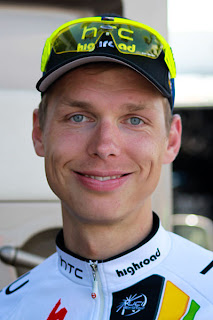 |
| Louis Trousselier, 1905 |
67 years later, another Classic took place on this day - the 36th edition of La Flèche Wallonne in 1972. It ran for 249.5km (the longest parcours since 1947) between Verviers and Marcinelle and the winner was Eddy Merckx, who then won Liège-Bastogne-Liège a few days later to become the third man to win the Ardennes Double. In 2003, the 67th edition also fell on this date. That year, it ran over 199.5km between Charleroi and Huy and was won by Igor Astarloa, the first Basque rider to achieve victory in this race. The 72nd edition, which took place in 2008, was the last time that the race fell on this date. It ran again between Charleroi and Huy and used a very similar route, once again measured at 199.5km, and it was won by Kim Kirchen whose career ended two years later when he suffered a heart attack during the Tour de Suisse.
 |
| Nicole Cooke (image credit: Gsl CC BY-SA 2.5) |
The Vuelta a Espana has started on this date five times - in 1969, 1970, 1974, 1985 and 1987. The 1969 edition was unusually short at "just" 2,921.4km, which were covered in 18 stages. Frenchman Roger Pingeon won and would have won the Tour de France that year too had it not have been for Eddy Merckx. In fifth place was Michael Wright, the English rider who didn't speak English - soon after Wright's birth in Bishop's Stortford, his father was killed during the Second World War. His mother later remarried to a Belgian soldier and the family relocated to Liège. It took some time for the Belgian love of cycling to take hold, however: he had originally wanted to be a footballer and it was only when his stepfather died that he switched to cycling in order to be able to support his mother and siblings.
1970 was extended to 19 stages and covered 3,568km and Agustín Tamames emerged from nowhere to announce himself as a future great - in his very first Vuelta, he led all the way until the Stage 19b individual time trial where Luis Ocaña took the overall victory. Tamames would win five years later. 1974 was another comparatively short edition, the 19 stages covering 2,987km. The winner was José Manuel Fuente, a highly respected climber who also won in 1972 and took the King of the Mountains four times altogether. Just a year later, still seemingly at the height of his powers, he would be forced to retire with the kidney disease that killed him in 1996.
 |
| Robin Morton (unknown copyright) |
1987 covered 3,921km in 22 stages. Irishman Sean Kelly, one of the favourites, won two stages, wore the gold race leader's jersey for four and looked very much as though he was going to win his first Grand Tour until he was forced to abandon with a painful boil on his perineum during Stage 19. Laurent Fignon won the stage, but the Colombian Luis Herrera took over the leadership and won the race overall - the first ever Grand Tour victory by a South American rider.
Tony Martin
 |
| Tony Martin (image credit: Petit Brun CC BY-SA 2.0) |
Martin won the National Junior Individual Time Trial title in 2003 and rode with the winning Team Pursuit squad ain the Team Pursuit Championship a year later. He joined Gerolsteiner as a trainee in August 2005, then moved on to Thüringer Energie for the next two seasons during which we won the Under-23 categories at the Thüringen-Rundfahrt (2006 and 2007) and National ITT Championships (2006), results sufficiently impressive to earn him his first full professional contract with Bob Stapleton's legendary Team Highroad for 2008. He remained with the team as it went through the transformation from Team Columbia, Columbia-HTC and HTC-Columbia to HTC-Highroad, the name under which the outfit raced its final season in 2011 before lack of sponsorship brought it to an end.
During his first professional year he won three time trials, then in 2009 he won the time trials at both the Critérium International and Bayern-Rundfahrt and a bronze medal racing at Elite level at the World Time Trial Championship where he finished 2'30.18" behind Fabian Cancellara. He also revealed a talent that is almost unique among time trial specialists - his ability to climb, and climb fast; as was proven when he won the King of the Mountains at Paris-Nice and the Tour de Suisse and, perhaps most telling of all, 2nd place behind Juan Manuel Gárate in a very tough Stage 20 at the Tour de France which finished at the top of cycling's most feared climb, Mont Ventoux.
 |
| Martin wins the 2011 ITT Championship (image credit: Mogens Engelund CC BY-SA 3.0) |
Cancellara remains a formidable opponent in a time trial, winning the Swiss National Championship in 2011 and while the rest of the year was far from his best there's every reason to expect a return to form in 2012. Whether he can regain his World title remains to be seen, but it's safe to say that at 31 his career is far from over. Martin, however, is 26 and, arguably, by far a better all-rounder despite Cancellara's Classics success; and if he continues improving at the rate he has done over the last three years it wouldn't be at all reasonable to predict a Grand Tour victory within five years.
Other births: Gintarė Gaivenytė (Lithuania, 1986); Simone Mori (Italy, 1972); Kathy Lynch (New Zealand, 1957); Jack Hartman (USA, 1937); Jure Pavlič (Yugoslavia, 1963); Tore Milsett (Norway, 1944); Paul Nixon (USA, 1914, died 2008); Kenneth Sutherland (Belize, 1943); Aimé Fritz (Germany, 1884, died 1950); Marcel Stäuble (Switzerland, 1961); Charles Hansen (Denmark, 1891); Luigi Magnotti (Italy, 1895, died 1948); Eduardo Bustos (Colombia, 1937).

No comments:
Post a Comment